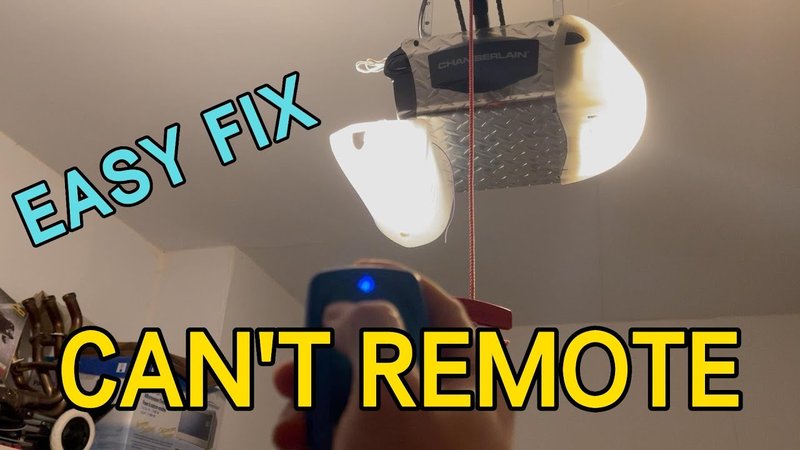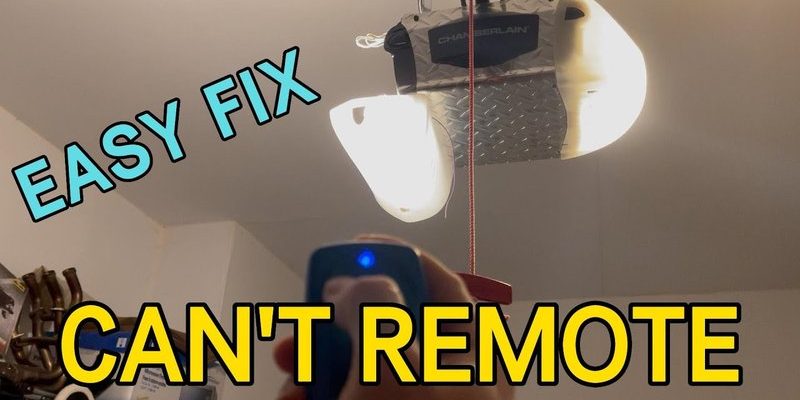
Here’s the thing: an Overhead Door remote is supposed to make life simpler, not add to your list of mysteries. If you’re standing in your driveway, mashing the button with zero results, you’re not alone. Lots of garage door openers, especially the popular Overhead Door brand, use flashing LEDs as their secret code for troubleshooting. Let me walk you through what those flashes really mean, why they happen, and—most important—exactly what you can do about it today.
Why Is My Overhead Door Garage Remote LED Flashing?
Nothing disrupts your daily routine quite like a garage door that just blinks at you and stays stubbornly shut. You might be tempted to think something’s broken, but a flashing LED isn’t always bad news. Think of it more like a friend urgently flagging you down—there’s a message in those blinks.
On an Overhead Door remote, the LED acts as a status indicator. Usually, *one steady flash* means the remote is transmitting normally. But when you get *rapid blinking*, *two blinks*, or *no light at all*, your remote is trying to get your attention. Common reasons? The battery’s low, the remote’s lost its code sync, or the receiver isn’t recognizing it. Sometimes, it’s as simple as a *reset* or battery swap. Other times, it might be a deeper pairing issue with your opener unit.
Most Overhead Door remotes fall into two camps: those with a single big “learn” button, and those with a row of dip switches or multiple configuration buttons. In both cases, the LED is the main way the remote talks back. Pay attention to the pattern—that’s your first clue in this troubleshooting puzzle.
Common Causes Of Flashing LED On Garage Remote
Honestly, there are only a handful of likely culprits, but some are sneakier than others. The number one troublemaker? Weak or dead batteries. Even if the LED still lights up, a fading battery can cause weird behavior—maybe your remote blinks but doesn’t actually transmit a strong enough signal to the opener.
Another familiar cause: code mismatch or lost sync. Maybe the remote was accidentally reset, or your opener unit had a power surge and forgot all its paired devices. In these cases, the LED may flash rapidly or blink in bursts every time you press the button.
Sometimes the issue is with physical damage or dirty contacts. Drop your remote in a puddle, spill coffee on your dashboard, or let the dog chew on it (don’t laugh, it’s more common than you think), and you could be looking at a short or broken circuit. The LED will blink, but the remote’s not really “talking” to the opener.
Other times, there’s interference—maybe you’ve got a neighbor with a similar setup, or some new electronics are messing with the signal. The remote blinks because it’s working, but your opener is getting scrambled messages.
How To Replace The Battery In An Overhead Door Remote
You’d be amazed how often a simple battery swap brings a remote back from the dead. Here’s exactly what you need to do, even if you’ve never cracked open a gadget before:
- Look for a small screw or a sliding latch on the back of the remote. If there’s a screw, use a mini Phillips screwdriver (the kind for eyeglasses works).
- Carefully pop open the remote’s case. Inside, you’ll find a round coin-style battery—usually labeled CR2032 or something similar.
- Note the orientation of the battery before removing it. Use a fingernail or plastic tool to pry it out.
- Pop in a fresh battery, matching the positive and negative sides.
- Snap the case shut and test the remote. If the LED is steady and the door responds, you’re all set.
If your LED is still flashing and the door won’t budge, don’t panic. At least you’ve ruled out the easiest fix, and you’ve saved a few dollars at the repair shop.
How To Reset Or Resync Your Overhead Door Remote
You might be wondering—what if a new battery didn’t fix it? Here’s where syncing comes in. Modern Overhead Door garage openers use a “rolling code” system for security, so sometimes the remote and opener just stop speaking the same language.
To reset and pair your remote, follow these steps:
- Find the “learn” or “program” button on your garage door opener unit (usually on the back or side of the motor, sometimes behind a panel).
- Press and hold the learn button until the indicator light on the opener blinks (usually about six seconds).
- Let go, then press the button on your remote. You should see the LED flash. If the opener’s light blinks or clicks, it’s paired.
- If not, repeat—sometimes it takes a couple tries to lock in the new code.
If your remote’s LED flashes but the opener ignores it, this pairing process usually does the trick. If not, you might need to clear all codes from the opener and start fresh. Check your model’s manual for the exact process—some require you to hold the learn button extra long to do a full reset.
Remember, don’t stand too far from the opener when pairing. Thick garage walls or cars in the way can interrupt the signal.
Troubleshooting Flashing LED Patterns: What Do They Mean?
LED flashing isn’t just random—Overhead Door remotes use specific blink patterns to signal what’s wrong. Let me explain the most common ones you’ll see:
- Single Blink: Everything’s fine. The remote is transmitting normally and should open your door.
- Rapid Flashing: Usually means the battery is weak or the remote is failing to find the receiver.
- Double or Triple Blinks: Often indicates a code mismatch or a failed sync attempt.
- No Light: The remote isn’t getting power—either the battery is toast, or there’s a physical problem inside.
If you’re seeing a unique pattern (maybe four blinks and a pause), your specific model may use custom codes. You’ll need to dig into the manual. In my experience, though, most issues come down to battery, sync, or interference. Test one thing at a time, and don’t skip steps thinking, “That can’t be it.” The simplest fix is usually the right one.
Pairing Challenges: Universal Garage Remotes vs. Brand Remotes
Here’s where things can get tricky. If you’re using a universal garage remote instead of an official Overhead Door model, you may see flashing LEDs for completely different reasons. Universal remotes need to be programmed to “speak the language” of your opener, and sometimes they get fussy.
Brand-specific remotes are designed to pair quickly with Overhead Door openers, using the learn button method. Universals, though, often use multi-step instructions—pressing certain buttons in sequence, waiting for specific flashes, and sometimes entering numbers with a paperclip or pen. The LED blinks to confirm each programming step, so you’ll want to follow your remote’s manual line by line.
If your universal remote LED just keeps flashing, double-check that it supports Overhead Door’s rolling code (often called “CodeDodger” or “Security+”) technology. Not all universals work with every brand, especially newer models with upgraded security.
Mixing brands? Don’t expect a universal remote to behave exactly like your original. Flashing patterns might mean different things, and pairing steps can vary a lot. If you get stuck, sometimes it’s less hassle to invest in an official replacement.
When To Replace Your Overhead Door Garage Remote
If you’ve tried new batteries, reset the codes, and followed every troubleshooting trick, but the LED keeps flashing and your garage door won’t budge, it’s probably time for a new remote. Unfortunately, like anything electronic, remotes do wear out—buttons get mushy, internal contacts corrode, and the radio chip can fail over time.
A new Overhead Door remote isn’t all that expensive, and swapping one out is way easier than you might think. Just make sure you buy the correct model for your opener (or a compatible universal), then follow the pairing steps above. The LED will flash during setup—but if everything goes right, it’ll settle down and work like new.
Here’s a little story: I once spent half a Saturday swapping batteries, re-syncing, and even standing on a chair waving the remote in the air (I know, not my brightest moment), before I realized the remote itself just needed to be replaced. Sometimes, when all else fails, save yourself the headache.
Caring For Your Remote: Prevent Future Flashing LED Issues
Don’t wait until your Overhead Door garage remote starts flashing again. A little bit of preventative care goes a long way:
- Keep the remote dry—avoid leaving it in sweaty glove compartments or dropping it in puddles.
- Change the battery proactively every year, especially before winter or rainy seasons.
- Clean the contacts inside the remote gently if you notice any corrosion or stickiness (a cotton swab with a dab of rubbing alcohol works wonders).
- Store your spare remote inside the house, not in the car, to avoid temperature extremes that shorten electronics’ lifespan.
Trust me, it’s a lot nicer to deal with a battery swap in your kitchen than standing outside in your slippers on a cold morning, watching that little LED blink at you helplessly.
Final Thoughts: Getting Your Overhead Door Remote Working Again
Flashing LEDs on Overhead Door garage remotes aren’t just random annoyances—they’re your device’s way of sending an SOS. The good news? Most problems boil down to simple fixes: batteries, pairing, or occasionally a new remote. Take the time to check each step carefully, and don’t be afraid to retrace once or twice if things don’t click on the first try.
There’s something satisfying about pressing that button and watching your garage door glide open, knowing you figured it out yourself. Next time the LED starts blinking, you’ll know exactly what it’s trying to say—and how to get back to smooth, reliable operation. If you ever get stuck, remember you’re not alone. Take it step by step, and you’ll be back in business before you know it.
